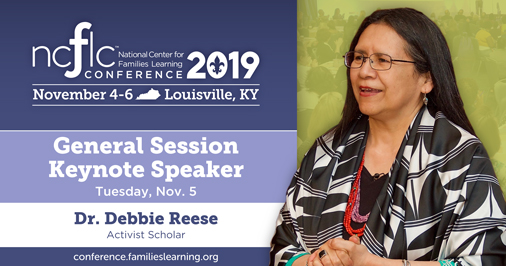Guest post: The search for mirrors in children’s literature
The following is part of a series of guest posts by leaders in the field of literacy and family learning. This post is authored by Debbie Reese, who is tribally enrolled at Nambé Pueblo, a sovereign Native nation in New Mexico, and whose writings are taught at universities and colleges across the U.S. and Canada. Dr. Reese will deliver a keynote speech at the 2019 Families Learning Conference.

When we think of stories and young children, we probably think of parents reading to their children. What we often don’t think about is the stories and how they are shaping what a child knows about the world and the people in that world.
In 1990, Dr. Rudine Sims Bishop, an education professor at The Ohio State University, put forth a metaphor that books can be “Mirrors, Windows, and Sliding Glass Doors.” What she meant with “mirror” was that if the character in a book looks like the child reading the book, that child has a mirror that affirms their experience.
I think we would like all children to have an abundance of mirrors, but that is not the case. As this infographic shows, the four children on the left have very few mirrors compared to the child on the far right.
_1.jpg)
Source: https://readingspark.wordpress…
Now, look at the floor by their feet. See the shards of glass by the children on the left? Not only are their mirrors small, but they are also broken. When we created this graphic, we wanted to show that many of the books about them are not good mirrors. Instead, many of those books have stereotypical images and words, factual errors, and biased storylines. The data on the infographic can galvanize all of us to ask publishers to do better. Books that more accurately reflect the lives of Native and children of color are the windows in Dr. Bishop’s metaphor. Books that function as windows let us see and learn about people whose lives are different than our own. And books that are sliding glass doors? Those are the ones that we can slide open, walk through, and be in the world that the author created.
No doubt you know that people in the United States are, once again, thinking hard about diversity. As you look over your bookshelves, whether they are in a classroom, office, or home library, do you have mirrors? Windows? Sliding glass doors? My area of research and writing is how Native peoples are depicted in children’s books. I invite you to visit my website, American Indians in Children’s Literature, and learn to see what I see in popular, classic, and best-selling children’s books.
ABOUT THIS POST
_(1).jpeg)
Tribally enrolled at Nambé Pueblo, a sovereign Native nation in northern New Mexico, Dr. Debbie Reese’s writings are used in English, Library Science, and Education courses at universities and colleges in the US and Canada. She publishes an online resource, American Indians in Children’s Literature, that is widely used by people in the creation, publication, review, and teaching of children’s and young adult books. In 2018, the American Library Association selected Reese to deliver its 2019 May Hill Arbuthnot Honor Lecture. She will give a keynote speech at the 2019 Families Learning Conference on Wednesday, Nov. 6 entitled, “Fact and Fiction in Children’s Books about American Indians.”